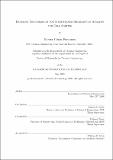Enabling technologies for multiplexed biomolecule analysis and cell sorting
Author(s)
Pregibon, Daniel Colin
DownloadFull printable version (11.82Mb)
Other Contributors
Massachusetts Institute of Technology. Dept. of Chemical Engineering.
Advisor
Patrick S. Doyle and Mehmet Toner.
Terms of use
Metadata
Show full item recordAbstract
The quantification and manipulation of biological entities from a physiological sample is extremely important for a broad range of applications in medical diagnostics, therapeutics, and basic science research. From a diagnostics standpoint, the cells, proteins, and nucleic acids that compose our bodies contain an enormous amount of information that can indicate the presence of, progression of, or even susceptibility to a given disease. However, extracting this information is often quite challenging. New tools are constantly being developed to make diagnostic testing more accurate, less invasive, faster, and less expensive. To this end, this thesis describes that advent of technologies to (1) precisely pattern biologically- and magnetically-active beads in hydrogel substrates for cell sorting and pattering, (2) synthesize morphologically and chemically-complex microparticles in a high-throughput fashion, and (3) perform rapid and accurate multiplexed biomolecule quantification using such particles. Bead-Patterned Hydrogels are a class of materials developed in this thesis that consist of microbeads precisely patterned in poly(ethylene glycol) (PEG) matrices. Using microfluidics and projection lithography on a standard microscope, magnetically-active or protein-decorated beads were patterned in close-packed or disperse-bead patterns on glass substrates with high resolution over large areas. Using slight alterations to ... bio-inert PEG matrix, or exposed from the PEG surface. It was shown that bead-patterned hydrogels could be used for the phenotype-specific sorting or patterning of lymphocytes. As was observed in the synthesis of bead-patterned hydrogels, free-radical polymerization is inhibited near microfluidic channel walls due to oxygen diffusion through the porous polydimethoxysilane (PDMS) elastomer composing devices. (cont.) By exploiting this phenomenon using ... an all-PDMS device, C graphy was developed. In stark contrast to traditional methods for anisotropic particle synthesis, this one-phase process provides a simple method to synthesize microparticles with complex morphologies and/or multiple adjacent chemistries in a high-throughput fashion. The processes is broadly applicable to any free-radical reacting monomer. For improved resolution and sharpened interfaces between adjacent chemistries ...
Description
Thesis (Ph. D.)--Massachusetts Institute of Technology, Dept. of Chemical Engineering, 2008. This electronic version was submitted by the student author. The certified thesis is available in the Institute Archives and Special Collections. Includes bibliographical references (p. [109]-122).
Date issued
2008Department
Massachusetts Institute of Technology. Department of Chemical EngineeringPublisher
Massachusetts Institute of Technology
Keywords
Chemical Engineering.